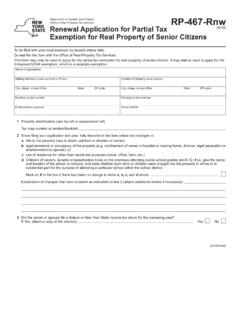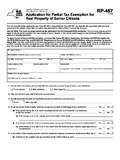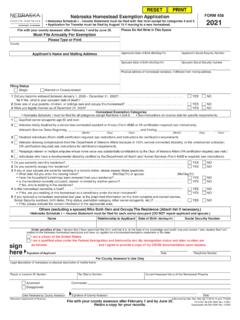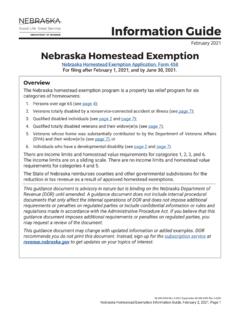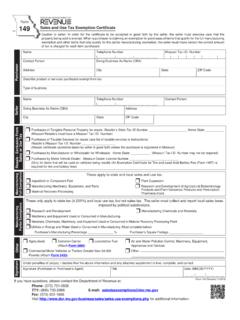Transcription of VAT partial exemption toolkit - GOV.UK
1 VAT partial exemption toolkit Published June 2020. Index Introduction .. 3. Areas of risk within VAT partial exemption .. 3. Using links within this document .. 7. Checklist for VAT partial exemption .. 8. Explanation and mitigation of risks .. 11. Effective from 31 January 2020 2. Introduction Tax agents and advisers play an important role in helping their clients to get their tax returns correct. This toolkit is aimed at helping and supporting tax agents and advisers in completing VAT Returns on behalf of their clients, although it may also be of use to anyone who is completing a VAT Return. It may also be of use to tax agents and advisers who do not complete their client's VAT Return but wish to use it as a source of reference when advising their client on VAT matters or for reviewing their client's VAT declarations at the year end. This version of the toolkit was published in June 2020. The risks in this toolkit have been reviewed and updated where necessary.
2 Its use is entirely voluntary. The content of this toolkit is based on HMRC's view of how tax law should be applied. Its application to specific cases will depend on the law at the relevant time and on the precise facts. For further information on using this toolkit and taking reasonable care under HMRC's penalty system see Tax agents' toolkits. For guidance on matters not dealt with in this toolkit you should refer to the partial exemption Manual (PE). Areas of risk within VAT partial exemption A VAT registered business can reclaim the input tax that it incurs on expenditure which relates to supplies which are: UK taxable supplies (standard, zero or reduced rate). Supplies made outside the UK which would be taxable if made in the UK. Certain exempt supplies specified by Treasury Order known as 'specified supplies' which are a range of supplies made to persons belonging outside the UK that would be exempt finance or insurance supplies if made in the UK, supplies which relate directly to the export of goods or supplies made by intermediaries in relation to these types of supplies.
3 There are further 'specified' supplies relating to investment gold. For the purposes of this toolkit all these supplies are referred to as 'taxable supplies' and the input tax on the related expenditure as 'taxable input tax'. Input tax which relates to exempt UK supplies or supplies that would be exempt if made in the UK (other than 'specified supplies') cannot be claimed unless it is below a prescribed de minimis limit. These supplies are referred to in this toolkit as 'exempt supplies' and the related input tax as 'exempt input tax'. When a business makes only taxable supplies the process for claiming input tax is generally straightforward. However, when a business incurs input tax that relates to both taxable and exempt supplies it becomes partly exempt. The partial exemption standard method sets out the mechanism for calculating how much input tax can be claimed in these circumstances and must be followed unless an alternative special method is formally agreed with HMRC.
4 Record keeping Good record keeping is essential, as poorly kept records can mean that the VAT Return is prepared on the basis of inaccurate or incomplete information. A partly exempt business must correctly determine the VAT liability of supplies it makes or intends to make in order to correctly attribute its input tax for partial exemption purposes. The accounting system should therefore be adequate to ensure that all relevant transactions are identified and accurately recorded. Effective from 31 January 2020 3. For further information on record keeping see Record keeping (VAT Notice 700/21) and VAT. Traders' Records Manual. Recognition of the need for a partial exemption calculation Many businesses do not realise that they are partly exempt as they do not recognise that they are making or intending to make exempt supplies. For a list of exempt supplies see Q2. Alternatively, a business may be unfamiliar with the partial exemption rules or conclude incorrectly that its exempt input tax is below the de minimis limit.
5 A partly exempt business is only de minimis in any VAT period where its total exempt input tax is less than 625 per month on average and no more than 50% of its total input tax, or it meets one of the simplified de minimis tests for smaller businesses - for further information see Section 11 of partial exemption (VAT Notice 706). It is common for a business to become partly exempt as a result of exempt land and property transactions which may be outside its main business activities. Attribution In each VAT period a partly exempt business must allocate its input tax as fully and accurately as possible to one of three categories: directly attributable taxable input tax (incurred on expenditure only to be used to make taxable supplies and recoverable in full). directly attributable exempt input tax (incurred on expenditure only used or to be used to make exempt supplies and not recoverable subject to the de minimis rules).
6 Residual input tax (incurred on expenditure that cannot be wholly attributed to either taxable or exempt supplies). Most business overheads (such as accountancy fees and stationery) are generally residual, as is expenditure which partly relates to both taxable and exempt supplies (such as an advertisement for both taxable and exempt products). Residual input tax is sometimes referred to as being 'non-attributable' or 'the pot'. While the principle of attributing input tax to use is straightforward, it can sometimes be difficult to apply in practice. Whether any individual item of expenditure can be directly attributed to taxable or exempt use is a question of fact to be decided on the particular circumstances of each case. Accurate attribution is also dependent on the understanding and consistency of the person entering individual purchases and expenses to the records, and errors can often occur as a result of oversight or misunderstanding.
7 Apportionment Once input tax has been directly attributed as far as possible to taxable and exempt use, the purpose of any partial exemption calculation is to determine the proportion of residual input tax which is attributable to taxable supplies and can therefore be claimed. The standard method, which apportions residual input tax on the basis of the ratio of the value of taxable supplies to total supplies, must be followed unless an alternative special method has been formally approved by HMRC. If a business considers that the standard method does not produce a fair apportionment of residual input tax, it may apply to HMRC to use a special method. This toolkit does not address the detail of individual special methods which are particular to the circumstances of each business and must be considered accordingly. Whether a business uses the standard method or an approved special method, the apportionment made should reflect the way it uses the residual input tax to make supplies.
8 The business should regularly consider whether its method remains a valid measure of that use. The annual adjustment may be a convenient time to do so. Effective from 31 January 2020 4. The annual adjustment Under the standard method a partly exempt business uses the recovery rate calculated under the previous year's annual adjustment to apportion its residual input tax through the course of the current partial exemption tax year. A business may alternatively choose to carry out a separate partial exemption calculation for each monthly or quarterly VAT Return period. Whichever approach is adopted, the amount of input tax claimed as a result of each period calculation is provisional and is only finalised through a 'longer period calculation' which is often known as the 'annual adjustment' and generally covers a period of 12 months. The annual adjustment uses the values for the whole of the period in question, comparing the result to the cumulative result of the individual return period calculations.
9 It also accounts for any changes in use or intended use during the annual adjustment period. Any resulting difference is payable to or recoverable from HMRC. Adjustments to partial exemption calculations may also be required if input tax is claimed, or credit notes issued or received, after the annual adjustment period to which they relate. Changes of intention Input tax is initially attributed on the basis of intended use. However, if a business subsequently changes its plans and the liability of the intended use changes before actual use occurs, this initial attribution must be revisited. If the change of intention occurs after the end of the longer period in which the input tax is incurred, the required adjustment is known as 'clawback' when input tax must be repaid to HMRC or 'payback' when additional input tax can be recovered. The need for such adjustments is often overlooked. Capital Goods Scheme For most purchases the final level of input tax recovery is determined by the annual adjustment calculation.
10 However, for specified assets the level of taxable use must be monitored for up to five or ten years, with any variation in the extent of taxable use requiring an adjustment to the initial input tax deduction. The Capital Good Scheme (CGS) applies to purchases of land and buildings where the value of the standard and reduced rate supplies received (excluding VAT) is 250,000 or more, and to purchases of computer equipment with a value of 50,000 or more (excluding VAT). With effect from 1 January 2011 the CGS has been extended to include purchases of aircraft, ships, boats and other vessels with a standard or reduced rate value of 50,000 or more (excluding VAT). A business may either fail to identify assets subject to the CGS or make errors in the CGS calculation. For purchases of items subject to the CGS made after 1 January 2011, the CGS calculation requires adjustments to input tax in relation to changes in levels of non-business or private use of the asset in question, as well as to changes in levels of taxable and exempt use.










